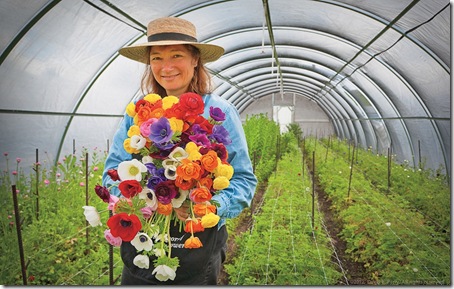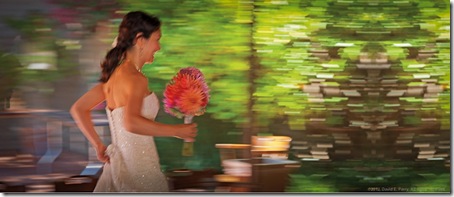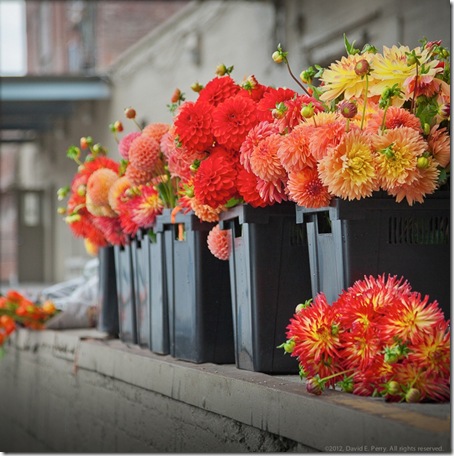The 50 Mile Bouquet is one of those books that gardeners (and those who love flowers) should have on their bookshelves. Debra Prinzing has done a stupendous job of inspiring and educating us about the slow flower movement. David Perry’s photographs….as always….don’t disappoint. They capture the sumptuous beauty of the flowers and the emotions on the faces of the growers. Fran Sorin
For our readers who aren’t familiar with you, can you tell them a bit about yourself?
Like many of us in garden writing, I have an eclectic background. Mine combines design and journalism, with a large dose of horticulture thrown in. I have an undergraduate degree in textiles and clothing, which led me to my first job in New York City at Seventeen Magazine in the early 1980s. When I moved back to Seattle, where I had spent three years in college, I worked for $500/month as an assistant editor at a women’s magazine and in marketing for an architectural textile design firm. That’s also when I started freelancing for design trade publications and started thinking about graduate school. In 1987-88, I spent a year at the University of Washington’s graduate school of Communications where I did all my master’s coursework, with a reporting emphasis on Seattle’s emerging fashion industry. While I never obtained my degree, those studies launched me into business journalism and I spent the next decade working for our major local business newspaper, Puget Sound Business Journal (I covered the “chic beats” – architecture, advertising, media, retail, hospitality, graphic design, and apparel manufacturing).
By 1997, while pregnant with my second child, I remember sitting at my desk one day thinking: I’m sick of interviewing dot.coms and CEOs. I want to be a garden writer. That simple utterance reflected the heavy influence of two close friends who were landscape designers; I called them my muses.
So here we are, 15 years later, and thanks to an inherent understanding of design principles; a long tenure as a working journalist; and several years taking horticulture classes at the local community college, I can legitimately call myself a Garden Writer. My specialty is design-related topics and now I spend about 75 percent of my time covering garden-themed stories and 25 percent of my time writing about architecture and interiors.
What motivated you to write The 50 Mile Bouquet?
I was motivated to write The 50 Mile Bouquet over the course of a few years after photographer David Perry and I first met in 2006. We were introduced professionally and ended up scouting gardens together one day. That trip took us to an heirloom rose grower who David knew and from that visit we produced a beautiful story about her for Seattle Homes & Lifestyles. Since that initial meeting, David and I have shared a mutual obsession with the story of passionate flower growers/farmers – and their efforts to save the domestic cut flower industry from being decimated by imports. Additionally, I was motivated by a friendship with Amy Stewart, who wrote Flower Confidential in 2007. We like to think that The 50 Mile Bouquet picks up where her book leaves off – and we’ve continued that storytelling with a focus on the flower farmers and eco-designers. Amy did us a grand honor by writing the foreword for our book.
 |
| Diane Szukovathy of Jello Mold Farm in Washington’s Skagit Valley is a sustainable grower |
You write that ‘”until recently, conscious consumers were largely unaware of the decidedly non-green attributes of their floral purchase.” Why do you think that is so?
Consumers have been unaware of the non-green aspects of the cut flowers they purchase for several reasons:
· Limited choice. If all you see are generic, lifeless, cellophane-wrapped supermarket bunches of flowers then you may not be aware that there is a soulful, fragrant, natural alternative from local growers.
· Chemicals are invisible. You cannot really tell whether a “perfect” rose was raised on synthetic fertilizers, sprayed with pesticides and drenched in fumigants in order to clear U.S. Customs from a farm on a distant continent. And as far as I’ve been able to determine, the only thing U.S. Customs checks for is the appearance of bugs on those blooms. The prior application of chemicals is not even a consideration.
· No labeling. Country-of-origin labeling is required on produce, but not on flowers. Unless the retailer voluntarily labels the bunches and bouquets, the consumer may have the false impression of their origin. Last year here in Seattle, there was a retailer selling mixed bunches with a sticker that read: “Locally Hand-Tied in the Pacific Northwest.” To me, that was a subtle form of green-washing. It implied that the flowers were locally-grown. But really all that label meant was that someone here in Seattle took a bunch of imported flowers and gathered them together with a twist-tie.
You compare ‘green floral design’ to the authenticity of the slow food movement. Can you explain what you mean?
The notion of Farm-to-Table dining has been around for 40 years, ever since Alice Waters opened Chez Panisse in Berkeley. And since that time, the Slow Food movement has gathered its momentum, its supporters, and its believers. In culinary circles and among foodies, the farmer is the new rock star. We gobble up their food and gobble up heart-warming stories of the artisanal cheese maker, the organic vintner, the heirloom tomato farmer – it’s everywhere and it’s widely accepted that eating food that has made the shortest possible journey from the field to the table is “better” than the alternative. Now, we are witnessing the early efforts of the flower world to catch up with the culinary world. Restaurants and chefs should be leading this effort (and in a nascent way, many are)….if you’re so obsessed about the food you serve, you should be similarly conscientious about decorating the dining table with non-imported, sustainably-grown flowers. No, you do not eat those flowers. And some would argue flowers are a luxury. But that’s all the more reason why you shouldn’t damage the earth to enjoy them!
Are there certain personality traits or characteristics that the growers tend to share?
There are a few personality traits that come to mind. A love for the land and a desire to make one’s living off the land. And a passion for growing something beautiful that makes other people so happy. Jan Roozen, an elder statesman of the cut flower world, put it this way: “Some days when I’m out in the fields, doing some farm job, I stop and appreciate the relative quiet around me. I see that the act of growing something – and doing it well – gives me much satisfaction. It shapes my image of myself. Those moments don’t happen much, but they are all the more valuable because they aren’t all that often.”
 |
| Joan Ewer Thorndike of La Mera Gardens in Southern Oregon |
Can you share Tara Kolla’s story?
Tara Kolla left a career in public relations and marketing to grow romantic rows of sweet peas in her half-acre Los Angeles backyard and sell them by the bunch at her local farmers’ market. In doing so, she never expected to become the poster child of the city’s urban farming movement. But a disgruntled neighbor who thought her flower patch lowered his property values found a loophole that forced city officials to shut her down. Her farming efforts were stopped by L.A.’s 1940s Truck Gardening ordinance, which allowed the backyard cultivation of only vegetables for off-site sale — not flowers.
Tenacious and determined to see the law corrected, Tara and her supporters and farmers’ market customers launched the Food and Flowers Freedom Act. After more than a year of hearings and petitions, they succeeded in getting the ancient law changed to allow small backyard farmers to grow flowers, as well as food, for offsite sales through CSAs and farmers’ markets. Thanks to one passionate flower grower, the urban farming movement more alive than ever in Los Angeles, a place where access to healthy, organic produce and flowers is so desperately needed.
How many of the growers left a conventional job in order to follow their dream?
Many flower farmers plant their fields with annuals and perennials long before they turn to cut flowers as a full-time endeavor. It is the ideal “side gig” or “second career.” Many growers use their flower stands to augment sales of other crops or as a related business to say, landscape design. I keep meeting floral designers who barter or borrow land to grow their own cut flowers – to ensure they have unique, hard-to-find ingredients for their designs. But to answer your question specifically, I’d say that at least 25% of those we met left what you might consider a traditional career for flowers (people from marketing/PR, fashion, environmental professions, finance, academia and hospitality are now growing or designing flowers).
Did most of them have gardening experience prior to becoming growers?
Many grew up in a farming family and returned to that life after time spent in a mainstream profession. Others started out small, say with a single crop like sweet peas. And we found that nearly all boosted their knowledge by learning from other flower farmers. They joined the Association of Specialty Cut Flower Growers (www.ascfg.org), an excellent professional group that nurtures and educates flower farmers through networking and “grower’s schools” around the country. Like gardening, flower farming is often so regionally-specific; up-and-coming flower farmers rely on the wisdom of more established growers in their area. And most are generous in sharing their knowledge and experience with others.
Julie Chai, an Editor at Sunset Magazine, planned her wedding with locally grown flowers. From the photos, it looks phenomenal. Can you tell us about it?
Oh, it was simply wonderful. I’ve known Julie professionally and as a friend for more than a decade. She was at a dinner party at my home in February 2011 when she announced that she and her longtime sweetheart, George Lee, were going to get married that July. David was at that same dinner. As she described her plans to grow and design her flowers for the wedding at Sunset’s amazing campus in Menlo Park, California, immediately, the two of us started lobbying Julie to let us document her wedding — and flowers — for our book. Thankfully, she and George said “yes.”
 |
| Julie Chai captured in a pre-wedding moment |
We spent three days with Julie and her wedding party, following them to Corralitos Gardens as they hand-selected dahlias for their bouquets; and then as they harvested more blooms from the Sunset test garden; and finally as they assembled the bouquets and centerpieces, including hundreds of plump, blue-green succulents that Julie and George had propagated over the course of several months. The whole story took on a life of its own, and we were swept up in the festivities. That story is the heartbeat of our book – because it shows the reader that flowers can reflect your values and your personal style, especially on a momentous day like your wedding.
Who was the most unusual grower that you visited? Why?
That’s tough to say, because each grower has such a compelling story to share. But the growers who most influenced us are Diane Szukovathy and Dennis Westphall, owners of Jello Mold Farm in Mt. Vernon, Washington. Longtime friends of David’s, and by extension, my friends, Diane and Dennis are one-hundred-percent focused on being stewards of their eight-acre flower farm. They truly walk the talk and are hugely generous with their customers, fellow flower farmers, and the larger Slow Flower movement that’s sweeping the country. Together, with other growers, Diane and Dennis co-founded the Seattle Wholesale Growers Market Cooperative, a farmer-to-florist hub that has enabled 20 farmers in Washington, Oregon and Alaska to sell their crops through a new distribution channel. They started and have hosted an annual Growers’ School on their farm, educating 150 new flower farmers from around the region on sustainable growing practices and the business of flower farming. And they are advocates for third-party certification of flower farms, encouraging others in their profession to participate in programs like Salmon Safe, which recognizes agricultural land that is safe for regional watersheds.
Bess Wynick, the founder of Celadon and Celery Events, has built an unusual and exciting business. Can you tell us about it?
Bess is one of the young, inspiring voices in the high-end floral world (she calls her niche ‘Eco-Couture’). Through her New York and Los Angeles-based studio, Celadon & Celery, Bess designs for weddings, restaurants and corporate events, using ingredients from local farms in New York, New Jersey, Connecticut and California. She often bypasses the conventional wholesale channels and cultivates direct relationships with growers, ensuring that her ingredients are local, fresh, and of highest quality. During the winter months, when that’s harder to achieve in New York, Bess sources from domestic growers in California and Florida. Her goal is to use as many organic and sustainable practices as possible, and to create beautiful, surprising, and elegant arrangements. We focused our attention on another aspect of Bess’s business: teaching techniques of the pros to DIY floral designers. Bess and her team have educated thousands of brides and hostesses to learn to design their own flowers using eco-friendly techniques. Through education, Bess is changing the way would-be designers source and work with local flowers.
What did you personally learn from writing the book?
I learned that I am a pretty good floral designer myself! As one who loves to garden and has always cut from my own backyard to arrange vases filled with my favorite blooms, stems, branches or foliage, I now realize that gardeners like me are more knowledgeable about the ingredients we use because we grow them ourselves. We know when those plants bloom, what form or habit they take, and how to combine their textures to please the senses. So we’re uniquely qualified to design bouquets.
 |
| Dahlias grown by Dan Pearson of Dan’s Dahlias in Oakville, WA. |
What do you hope individuals take away….and put into action….from reading The 50 Mile Bouquet?
What we hope the reader gets out of this book:
· An understanding that there is a difference between a locally-grown flower and one that was produced continents away and shipped to you via airplanes and trucks. The difference should be a sensory one; behind the petals and fronds, there’s a big story about the global cut flower industry – and there’s nothing sustainable about that.
· A consciousness about where their flowers come from; how they were grown; and who grew them. Just asking the question raises awareness on all fronts.
· Not demanding all-flowers-all-the-time but valuing the uniqueness of a flower in its natural bloom moment — the season it is meant to be used and enjoyed.
Click on the following websites to learn more about Debra , David, and The 50 Mile Bouquet.
Please note: All photos courtesy of David Perry

